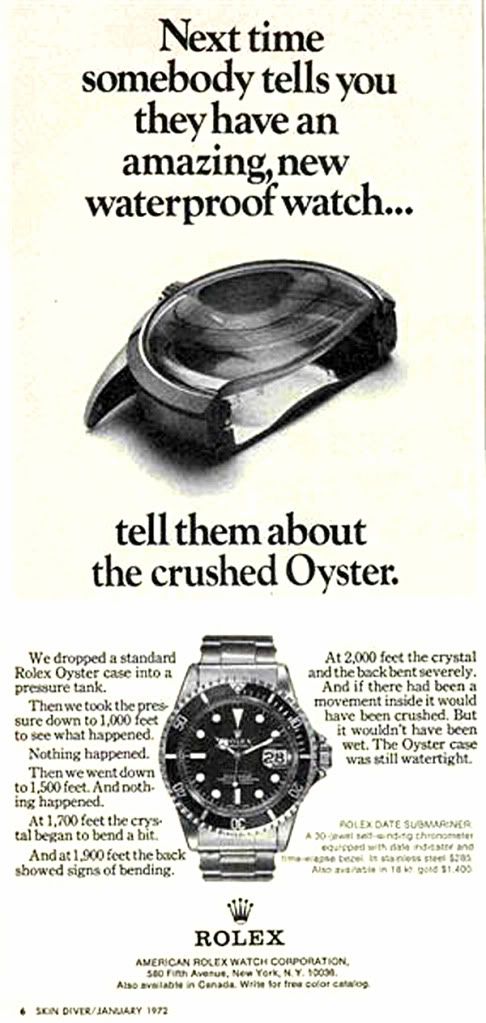
 |
ROLEXROLEXROLEXROLEXROLEXROLEX
 ROLEXROLEXROLEXROLEXROLEXROLEX
ROLEXROLEXROLEXROLEXROLEXROLEX
|
|
#1 |
|
TRF Moderator & 2024 DATE-JUST41 Patron
Join Date: May 2007
Real Name: Larry
Location: Mojave Desert
Watch: GMT's
Posts: 43,103
|
Why The GMT IIc Is Not As Waterproof As The Sub !!
Water resistance, and the differences between different Rolex Oyster cases - it's all about the caseback.
Keeping in mind that cases are stamped from a solid piece of 904L Stainless Steel, and the center is also stamped out, concurrently, then the center stamp is further machined to become the caseback for it’s corresponding shell. The cases of the Submariner (14060, 16610), the GMT II (16710, 116710), and the Explorer II (16570) are all generally the same. The difference is the cut out for the crown – with Triplock for the Submariner and GMT IIc, and Twinlock for the GMT/Explorer II, and final machining at the lugs for shape, and front and back sealing, rehaut, and bezel surfaces. They all share the same 2 mm thick crystal, as well as the crystal and caseback gaskets. The Triplock crown is designed to take 500 bars of pressure, and even though the Twinlock is not as massive, it can take an enormous pressure. When it comes to these models capabilities to take pressure, the real difference is the caseback. The Submariners have a thicker caseback at a respectable 1.51 mm compared to the ~ 0.75 - 0.90 mm of the GMT II/Explorer II. This difference becomes the weak point when handling pressure. Regarding the GMT IIc, the watch itself has a thicker initial case size than the 16710, but looking at the case-back, it is much flatter against the case rather than being slightly “bubbled out” like the earlier GMT’s and the Sub. This gives the GMT IIc an assembled thickness of ~12mm, almost the same as a 16710 (11.95mm), whereas the Sub 16610 is still thicker at ~13mm, and the 14060M at 12.20mm (thinner non-date movement). If you apply some rudimentary materials science on the crystal (at what pressure will the crystal crack), and on the caseback (at what pressure is deflection sufficient that the caseback touches the rotor) you will find that the Submariner is good for much more than its rated capability. In fact the caseback is so over-engineered that its margin is much more than twice the rated depth. Now, since the only real differences between those models are the crown (which is not really the weak point at all) and the caseback; it is fair to say that the pressure capability of the Explorer II and the GMT II depends on the caseback. And even though the case back is roughly half the thickness of the Submariners it is likely still good for a much higher pressure than the rated 100 meters. It is also worth noting that all 36mm and 40mm models share the same 2mm thick crystal (with the exception of the Sea-Dweller). The 36mm models also have the same thickness of the caseback as the GMT II/Explorer II. Here are some actual measurements of case back thickness provided by Vanessa and taken by me using a Vernier micrometer and converting to mm: GMT Master 16750 - 0.72mm Explorer II 16570 - 0.90mm Daytona 116520 - 0.96mm Submariner 16610 - 1.51mm (more than twice the thickness of the old GMT) Lady's DJ (older) 69174 - 0.50mm Lady's DJ (newer) 79174 - 0.49mm Gent's DJ (older) 16013 - 0.75mm Gent's DJ (newer) 16233 - 0.81mm Given this simple reasoning it should be easy to see that any Rolex Oyster is capable of taking a pressure much higher than its rating, and much more than any recreational diver will ever go down to. If you do an annual pressure test, or at least every two years, of your Rolex you can go diving with any model. Of course, the Triplock offers better safety when it comes to leakage through the crown. But what one seldom thinks about is the fact that there is still only one gasket between the crown tube, and the case. By the way: All models are tested by Rolex to 125% of their rated capability. This is what Rolex themselves said in an ad for the Acrylic crystal models, and since the only difference now is the material, and even better gaskets the facts should still apply. (Let’s assume that Rolex did use real facts in this test.) ..................................................  .......................................... ..........................................Contributors: acce1999 Vanessa Ironstark
__________________
(Chill ... It's just a watch Forum.....) NAWCC Member |
|
|

|
| Currently Active Users Viewing This Thread: 1 (0 members and 1 guests) | |
|
|
*Banners
Of The Month*
This space is provided to horological resources.